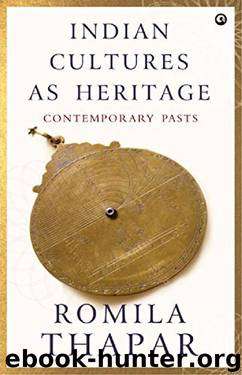Indian Cultures as Heritage: Contemporary Pasts by Romila Thapar

Author:Romila Thapar [Thapar, Romila]
Language: eng
Format: epub
Publisher: Alephrupa Publications
Published: 2018-02-28T18:30:00+00:00
6
THE CULTURE OF DISCRIMINATION
Observing exclusion and claiming identity to justify it, have been inherent in almost all societies since earliest times, and continue to be. What is not inherent are the reasons for this, the degree to which they prevail in a society, or for that matter the role that they play in giving form to the society. The reasons could provide pointers to the ethics, ideologies and values that govern a society and even what we call civilizations. We have tended to brush them aside or have not always found plausible explanations. But historical explanations today do try and answer such questions.
Social exclusion, common to most societies, is of different kinds. A power-wielding group excludes others dismissing them as inferior or deviant. The power can be based on anything ranging from physical force to superstition. Deprivations of various kinds become forms of discrimination, controlled by the conditions under which they are practised. Access to resources of livelihood can be restricted or even denied, the justification for this given a religious gloss or the claim that it was the command of deity, or even just an assertion of power.
Exclusion, is a demarcation and by its own logic those excluding and those being excluded, require an identity. Emphasis on one presumes an emphasis on the other. This is often a label that imprints the demarcation. Thus for example, those included in caste society are identified as the Savarna (included among the varnas), and the Avarna (those outside and excluded from varna identity).
Information on these practices comes to us from ancient texts. As I have pointed out earlier, in the ancient past, these texts were generally written by the elite and reflected their views. They provide an image of how society was envisaged by those in authority and incidentally also provide some clues, probably unintended, as to how it actually functioned. The norms for how society should function did not necessarily hold—as they seldom do. Where there is repeated insistence on a rule it could be due to its being observed infrequently or casually. For instance, does Ashoka Maurya repeatedly advising his subjects to honour the sect of the other person imply that this was not the norm? What is of interest to historians is the manner in which the difference between norm and practice was recognized, and then negotiated and adjusted. In theory, the norm was said to continue, in effect, it may have changed. However, rules could be subverted in subtle or even brazen ways, as we shall see.
It is thought that rules governing caste or what is referred to as varna-ashrama-dharma, determined all social relations. This was the regulation of the code of behaviour applicable to all varnas, or what might be called an ideal pattern in which caste society functioned; and ashrama, in this context, referred to the four stages of the life span of generally an upper-caste man—namely, being a student, then a householder, then leaving home, and finally becoming an ascetic.
However, a close inspection shows deviance.
Download
This site does not store any files on its server. We only index and link to content provided by other sites. Please contact the content providers to delete copyright contents if any and email us, we'll remove relevant links or contents immediately.
| Anthropology | Archaeology |
| Philosophy | Politics & Government |
| Social Sciences | Sociology |
| Women's Studies |
Nothing to Envy by Barbara Demick(1323)
The Pub by Pete Brown(1178)
On Sparta (Penguin Classics) by Plutarch(1114)
Transcendence by Gaia Vince(1081)
The Perfumes The A-Z Guide by Luca Turin(1043)
Mysteries of the Middle Ages by Thomas Cahill(997)
Albion by Peter Ackroyd(995)
A short history of nearly everything by Bill Bryson(956)
100 Techniques by Unknown(907)
Natasha's Dance by Orlando Figes(872)
How the Irish Saved Civilization by Thomas Cahill(826)
2120-2126 by Russell Fine(825)
The World Until Yesterday: What Can We Learn From Traditional Societies? by Jared Diamond(822)
The Way of the Shaman by Harner Michael(806)
The Wedge by Scott Carney(805)
The Lost Continent by Bill Bryson(795)
Ancient Iraq by Georges Roux(793)
Albion: The Origins of the English Imagination by Peter Ackroyd(792)
2024-2120 by Russell Fine(776)
